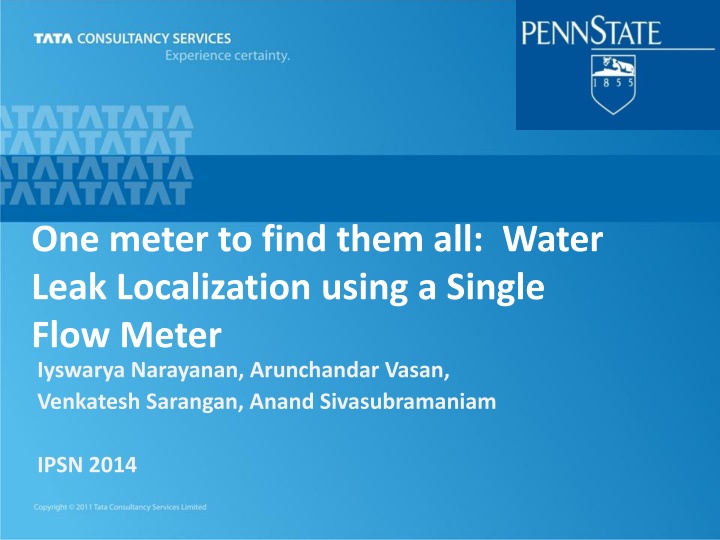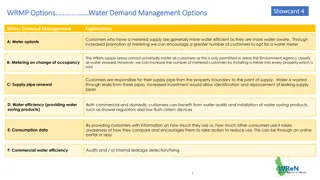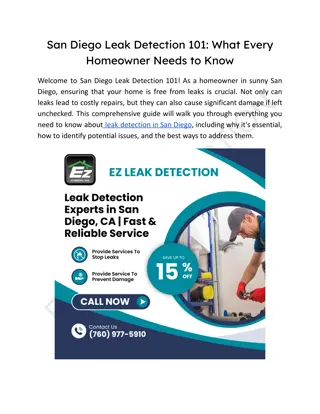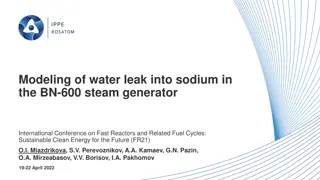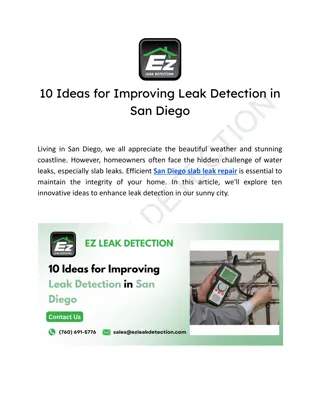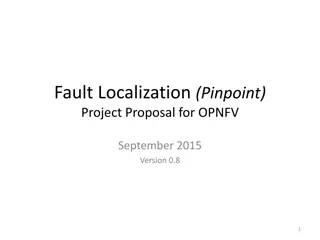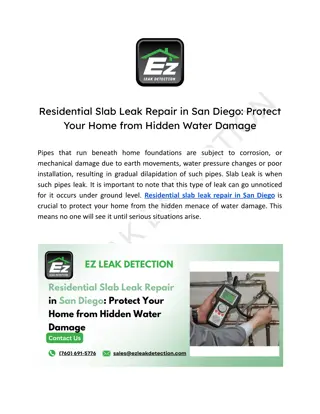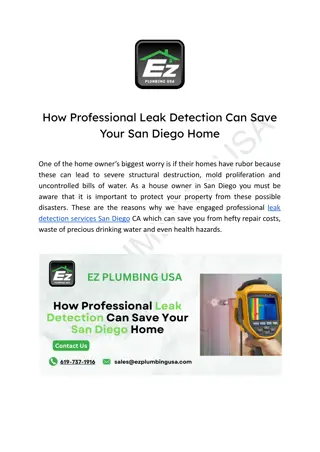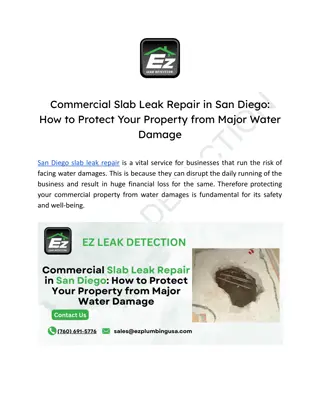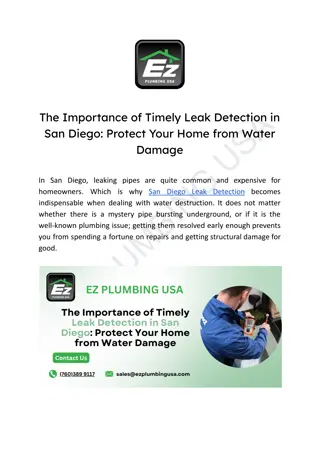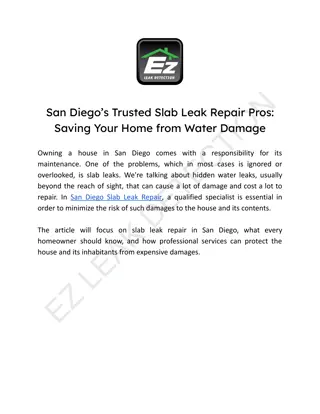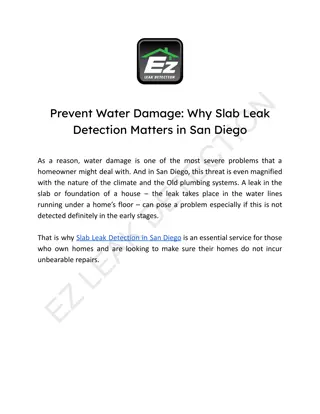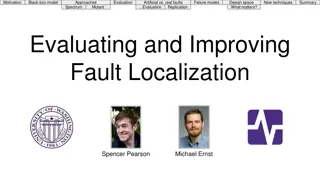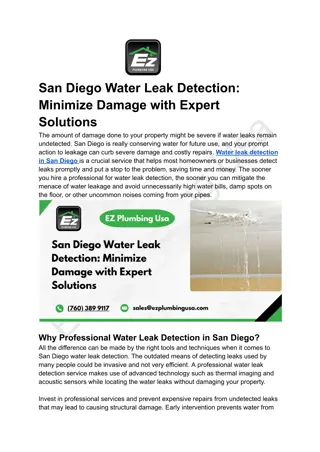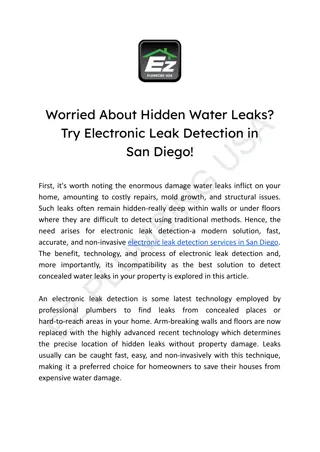Water Leak Localization using Single Flow Meter
Discover how water utilities can efficiently manage water availability, detect and fix leaks, and address the challenges of water distribution networks. Learn about the importance of reducing major leaks globally and the potential solutions for detecting and localizing leaks using single flow meter data.
Download Presentation

Please find below an Image/Link to download the presentation.
The content on the website is provided AS IS for your information and personal use only. It may not be sold, licensed, or shared on other websites without obtaining consent from the author.If you encounter any issues during the download, it is possible that the publisher has removed the file from their server.
You are allowed to download the files provided on this website for personal or commercial use, subject to the condition that they are used lawfully. All files are the property of their respective owners.
The content on the website is provided AS IS for your information and personal use only. It may not be sold, licensed, or shared on other websites without obtaining consent from the author.
E N D
Presentation Transcript
One meter to find them all: Water Leak Localization using a Single Flow Meter Iyswarya Narayanan, Arunchandar Vasan, Venkatesh Sarangan, Anand Sivasubramaniam IPSN 2014
Why Water ? Limited supply [ fresh water < 3% of earth's water] Nearly 1 billion people lack safe drinking water By 2030, in developing countries demand would exceed supply by 50%
Water Utilities: From source to consumers Pumping Station Water availability skewed Utility water supply networks Manage vagaries in water availability Typical source for direct human consumption Efficient way of water delivery Differentiator between sufficiency and scarcity Treatment Unit Leaks decrease efficiency DMA-District Metering Areas
Leaks and their importance NRW Levels: Non Revenue Water(NRW): Leaks + thefts Developed countries: 15% Developing Countries: 40-50% Reduce major leaks by half: Global losses: $14.1 billion p.a serve 100 million people
Detecting & fixing leaks Ideal solution: Perfectmetering Perfect hydraulic models Acoustic last mile localization DMA-1 EXPENSIVE !!! DMA-2
Practical Reality Imperfect hydraulic models Scarce Metering Metering challenges Access issues Economically not viable yet Calibration challenges Dynamic properties to be estimated Demands, friction coefficient
What data is available Single flow meter data at DMA inlet Network structure and static pipe properties Diameter Length
Problem Statement Given a water distribution network with No calibrated hydraulic model Low-frequency flow logging only at DMA inlet Can we detect and localize major leaks within DMA? Challenges in detection Seasonal trends Short-term dependencies Challenges in localization Major leaks of rare event Depends on operating conditions Data from a single flow meter
Solution Overview Single flow meter Leak detection Leak localization Static Network Structure + Time Series Analysis Build Signature Current flow centrality Detect burst and get signature Build Model Map signature to burst location
Leak detection: Trends in flow signal Short range dependence Daily correlation Weekly Correlation Xt Xt+1 Xt+1|Xt > 0.9 0.8 0.7 0.6 0.5 0.4 f(x) 0.3 0.2 0.1 0 3.5 4.5 5.5 6.5 7.5 8.5 Flow
Leak detection: Quality of fit Observed Predicted Time Error: 9.95% Use model to estimate (i) leak (ii) if leak, excess flow
Leak detection For consecutive alerts, false positive rate is A priori conditional distribution Pr(Xt|Xt , t t) (100 - ) th percentile = Pr( [ Xt|Xt > x( t) Xt+1|Xt > x( t+1) Xt+2 |Xt > x( t+2) ] ) = Pr(Xt|Xt > x( t) ) * Pr(Xt+1|Xt > x( t+1) ) * Pr(Xt+2|Xt > x( t+2) ) Leak signature = Excess flow Pr(Xt|Xt , t <t > x( ) ) = (1- ) Observed Sample: X t False positive rate: Given by X t - E[Xt]
Solution Overview Single flow meter Leak detection Leak localization Static Network Structure + Time Series Analysis Build Signature Current flow centrality Detect burst and get signature Build Model Map signature to burst location
An analogy: Short circuit current flow Current draw from battery A B C D A B C D Shorted location V Normal Current = (RA +Rc ) ||(RB+RD)
Leak flow in water networks Burst flow through meter A B C D A B C D Use customized version of current flow centrality to estimate the leak flows at different network locations. Resistance is determined by flow Iterative algorithm
Localization with consecutive leak samples Excess Flow Time
Experimental Setup Benchmark DMA Synthetic bursts oSimulation period: 24 hours oNodal demand: Added Gaussian error oTo Simulate bursts: Emitter coefficients Real-world DMA Inlet flow meter reading Ground truth: burst information from work-order information system Location: GIS data
Evaluation metrics Time to detect a leak Size of the candidate set For Synthetic, % of times the actual location is in the candidate set Comparison with accurate hydraulic model
Results: Benchmark DMA small leaks moderate leaks large leaks High : good Detection % Low: good small leaks moderate leaks large leaks Time to Detect (hr)
Results: Benchmark DMA Localization likelihood High : good % time node is in high probability set Search size Low: good Accurate Hydraulic Model Centrality Candidate set size in % of network size Node ID
Real world DMA DMA: Meter at inlet Sample interval: 15 mins Data duration: 21 months 56 nodes Burst logs: From Workforce Management Information systems
Real world DMA Search size: 22.5 % Avg. Distance : 148.45 m Search size: 28.6 % Avg. Distance : 126.7 m
In Summary, Leak detection and localization using a single flow meter Detection using time series analysis Localization wo accurate hydraulic models: Exploit network structure and its static properties Adapt centrality metrics Map burst flow to location Evaluation Benchmark topology: comparable with solutions from hydraulic model Real world DMA: pruned the search space by 78%
Thank you! Thank you!
Bursts and Network Structure Signature: Hydraulic admittance Discernable Signatures and SCC
Related Work Outlier Detection Offline outlier detection Either centralized or distributed Ours: ARIMA model Centrality Analysis Network analysis o Information or commodity flow o Influential actors in social networks o Spread of epidemics Infrastructure network analysis: o Smart Grids : Reliability analysis o Water network: Vulnerability analysis, sensor placement, etc Leak Localization Expectation: dense metering Wavelet analysis, pressure transients, Bayesian inference, automatic deployment and tracking of sensors, etc.
Convergence Solves non-linear equations coupled in Head and Flow Admittance-1 matrix ~ heuristic for Jacobian( H/ f)
Physics of water flow Flow is conserved Pressure drops along flow g/ R5 Similar to Kirchhoff s current and voltage laws But, resistance is non-linear
Using centrality Current flow centrality A Admittance Matrix LA Laplacian of admittance matrix p Potential Vector b Current Vector Iij Edge Current LA *p = b Iij = Aij *(pi pj) Hydraulic Admittance: aij: R5/CFC(ij)L Hydraulic Resistance: 1/ aij Current Flow Centrality of an edge = Avg( Iedge) for all (src,sink) pair
Normal Operating Conditions Get E[flow] value at time t Divide flow and assign demand to all nodes Use current flow centrality to compute head, flows p = L-1A b fij = Aij *(pi pj) Update L-1A using new fij
Burst signature estimation Excess flow Head difference
